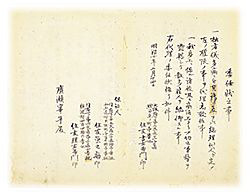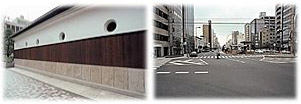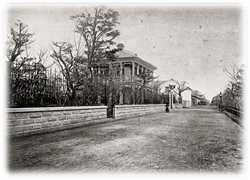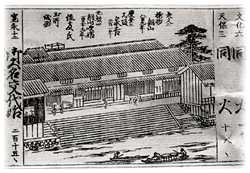Introduction
Seven director-generals led Sumitomo in the early modern era, securing the foundation of the enterprise and developing the business. They were (from the first to last): Saihei Hirose, Teigo Iba, Masaya Suzuki, Kinkichi Nakada, Kankichi Yukawa, Masatsune Ogura, and Shunnosuke Furuta. Each strove to align Sumitomo’s business with the development of Japan, contributing to the emergence of the modern nation state by pursuing management based on high ethical standards.
Before the war, Sumitomo’s chief executive was referred to as soriji or director-general. However, Saihei Hirose, although considered to be the first director-general, was in fact soridainin or sorinin (prime agent) of the House of Sumitomo, titles indicative of a role somewhat different to that of Teigo Iba and subsequent director-generals.
Mercantile houses of the Edo period employed the dainin (substitute, deputy, proxy, representative, agent) system whereby a person would act on behalf of the head of the house if the head were immature, infirm, or a woman. The term soridainin did not exist in the Edo period and was of later provenance. The term sori conveys the sense of overseeing and supervising an activity in its entirety and managing and dealing with every aspect of it. Today, sori is mainly used as an abbreviation of naikaku sori daijin (prime minister).
Director-General Saihei Hirose, the first person to hold that position, was soridainin (sorinin), an agent with authority as a representation whose scope was not restricted. Vested with unlimited authority of representation by the House of Sumitomo as an agent, it was his task to manage the business of the House of Sumitomo on behalf of the head of the Sumitomo family.
On the other hand, soriji, the title used for the second director-general onward, was elected by the riji (directors) on jyuyakukai (the executive board) and his task was to supervise riji (directors). The task of both soridainin (sorinin) and soriji was to manage the business on behalf of the head of the Sumitomo family, but Hirose was the sole “soridainin” of the House of Sumitomo and the soriji system as an institutional structure started with Iba, the second director-general.
Management structure in the Edo period
During the Kan-ei era (1624-1644) in the early Edo period, Masatomo, the founder of Sumitomo, left the priesthood started the publishing business and opened a shop selling medicines in Kyoto.
Tomomochi (married to a daughter of Masatomo), the second head of the Sumitomo family, made copper refining, which was the business of Riemon Soga, his biological father, the principal business of the House of Sumitomo, moved from Kyoto to Osaka (present-day Osaka City) in 1630 and started copper trading, too.
Tomomochi negotiated directly with the head of the Dutch Trading Post, in whose diary Tomomochi is described as a capable merchant. During the Kanbun era (1661-1673), Tomonobu, the third head of the Sumitomo family, began developing copper mines across Japan. He established a comprehensive system extending from copper mining through to refining and exporting while also taking his first steps as a moneychanger and financier. Tomoyoshi, the fourth head of the Sumitomo family, opened the Besshi Copper Mines in 1691 and reinforced Sumitomo’s business foundation.
Thus, the first four heads of the Sumitomo family were vigorously involved in business. However, from Tomomasa, the fifth head, onward, the heads of the Sumitomo family were less deeply engaged in business, with exception of Tomonori, the sixth head, and Tomohiro, the ninth.
When the head of the Sumitomo family was not involved in management, the head of a cadet branch of the family or the highest-ranking tedai (clerk) fulfilled the leading role in management.
According to the organizational structure of the House of Sumitomo from 1760 onward, shihainin (general manager) was the foremost executive followed by fuku-shihainin (deputy general manager), motojime (controller) and yakugashira (head administrator). Below them were various non-executive positions, including tedai (clerk), maegami (junior clerk), and kodomo (apprentice).
In addition, in exceptional circumstances, a retired manager was appointed robun (advisor) and in the event of a crisis, several robun returned to work as nikkin robun providing guidance.
In a present-day company, nikkin robun is equivalent to chairman, robun is an advisor, shihainin is president, fuku-shihainin is vice president, motojime is general manager, and yakugashira is senior manager.

 EN
EN




